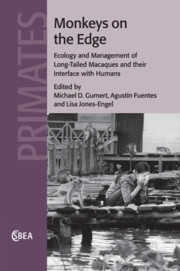Book contents
- Frontmatter
- Contents
- List of contributors
- Foreword
- Preface
- Acknowledgements
- Part I The status and distribution of long-tailed macaques
- Part II The human–macaque interface
- 4 Campus monkeys of Universiti Kebangsaan Malaysia: Nuisance problems and students' perceptions
- 5 Human impact on long-tailed macaques in Thailand
- 6 Macaque behavior at the human–monkey interface: The activity and demography of semi-free-ranging Macaca fascicularis at Padangtegal, Bali, Indonesia
- 7 The role of Macaca fascicularis in infectious agent transmission
- Part III Ethnophoresy of long-tailed macaques
- Part IV Comparisons with rhesus macaques
- Part V Understanding and managing the human–macaque interface
- Index
- References
4 - Campus monkeys of Universiti Kebangsaan Malaysia: Nuisance problems and students' perceptions
from Part II - The human–macaque interface
Published online by Cambridge University Press: 16 May 2011
- Frontmatter
- Contents
- List of contributors
- Foreword
- Preface
- Acknowledgements
- Part I The status and distribution of long-tailed macaques
- Part II The human–macaque interface
- 4 Campus monkeys of Universiti Kebangsaan Malaysia: Nuisance problems and students' perceptions
- 5 Human impact on long-tailed macaques in Thailand
- 6 Macaque behavior at the human–monkey interface: The activity and demography of semi-free-ranging Macaca fascicularis at Padangtegal, Bali, Indonesia
- 7 The role of Macaca fascicularis in infectious agent transmission
- Part III Ethnophoresy of long-tailed macaques
- Part IV Comparisons with rhesus macaques
- Part V Understanding and managing the human–macaque interface
- Index
- References
Summary
Introduction
Malaysia, in Southeast Asia, has a total landmass of 329, 845 km2, separated by the South China Sea into two regions, Peninsular Malaysia and Borneo (i.e., Sabah and Sarawak). Peninsular Malaysia is located south of Thailand, north of Singapore and east of the Indonesian island of Sumatra. The country comprises tropical rain forest with dipterocarp forests, peat swamp forests, and mangrove forests (Mohd-Azlan, 2006). The human population is about 28 million and consists of multi-racial ethnic groups with a majority of Malays, followed by Chinese, Indians and other minorities (Lim et al., 2004). The country is the home for 229 species of mammals (Lim, 2008) including 18–20 species of primate species (Brandon-Jones et al., 2004; Md-Zain et al., 2009).
In Malaysia, there are three species of macaques, pig-tailed macaques (Macaca nemestrina), stump-tailed macaques (Macaca arctoides) and long-tailed macaques (Macaca fascicularis) (Brandon-Jones et al., 2004). M. nemestrina is widely distributed within Peninsular Malaysia but mostly in the undisturbed forests and is hardly seen near to the coastal forests. M. arctoides can only be found in northwestern part of Malay Peninsula (Medway, 1969). Meanwhile, M. fascicularis can easily be found near rivers and low ground secondary forests and near to human settlements (Marsh and Wilson, 1981). Macaque populations in Malaysia have not received much attention as many researchers focus on ecology, behavior and genetics of their sister taxon, the leaf monkeys (e.g., Md-Zain et al., 2008, 2010a, 2010b, 2011; Matsuda et al., 2009).
- Type
- Chapter
- Information
- Monkeys on the EdgeEcology and Management of Long-Tailed Macaques and their Interface with Humans, pp. 101 - 117Publisher: Cambridge University PressPrint publication year: 2011
References
- 2
- Cited by



